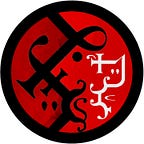The Whistling Witches
The Whistling Witches are born out of spite and live to spread it in a sadistic crusade against society.
Girls shunned by their families or who flee their homes in search of freedom can find help in the Witches, women who, like them, were forsaken by the world. Unmarried mothers, females opposing their assigned roles, as well as young and violent criminals can join the witches and be hosted in their houses in the middle of marshes or far into the woods. There, older women who were once like them teach the young women how to cast curses to get what they want, be it revenge, luxuries, or sadistic pleasure.
The whistling makes the orc witches famous everywhere, an unconventional way of casting spells that is neither wizards’ verbal incantations nor the musical magic of the bards. The whistles can be loud and sustained like screams of pain, or syncopated like the laughs of deranged birds. Earing such chilling sounds is more than a bad omen, is almost a guarantee that someone, maybe even yourself, will endure the wrath of a scorned woman soon.
The word “curse” has a technical meaning in the arcane lexicon, meaning a spell sustained by the target’s Life Force rather than the caster’s. You can “curse” a man with something positive, like enhanced sight, by funneling vitality into the eyes and manipulating the indigo mana of meta magic to keep the effect going through the subject’s life force. These spells are complex and fragile since the subject is unable to reinforce the spell as it becomes “stressed” by the ever-fluctuating mana field. Wizards will use sigils, potions to be regularly consumed, mental exercise, or other tools to help the spells go, meaning they can work for extended periods only on cooperative subjects. Whistling witches are masters in this practice, able to weave such tight yet exquisite magical knots that a curse can last for years.
Such curses are so effective not only because they have been refined to perfection by centuries-long tradition but also due to the witches’ fame. Believing in the curses’ power helps them consolidate: the witches entangle the magenta mana of mind in their weave, making it so that thinking about the curse reinforces it. This is one of the reasons why the witches foster their reputation as dreadful and wicked, choosing unsettling locations as home and monsters as pets: fearing them makes their magic stronger. They also enjoy the power of causing terror, a way to subjugate those who, contrary to them, have caste, a family, and a place in society.
Witches cast the curses for personal reasons or on behalf of others: a disgruntled wife may want to curse her unfaithful husband by making him lose the sense of taste or to humble the arrogant neighbors making their crop rot. Such requests can be big or small, righteous or petty, and each witch will choose based on her whims: while some act as avenging agents of justice, most just revel in the suffering they are causing, delighted by the misery falling on their hated community.
The witches don’t ask for gold as payment, they are idiosyncratic in their desires as they are in the request they will accept: they may ask for frivolities like fine clothes or sweets, or more practical things, like tools a week of housework. Sometimes requests will be unsettling, like demanding a child, maybe to be raised as their own or to be eaten, or sometimes they will ask for a lover, maybe the brother of the petitioner or her husband. These appalling askings are sometimes genuine but other times are just mind games to enhance the terrifying reputation of the witches, there is no way to know in advance.
The effects of the curses vary but usually concern the body: ailments of various kinds can be elicited, from pure pain to subtle malaises, and bodily modifications can be induced, like warping the nose, the teeth, or the fingers. Often these curses have a trigger, a circumstance that makes the effect start, like drinking alcohol or being out at night.
Curses can be dispelled by clerics, so they must be either subtle, to not be immediately detected, or immediately effective. To help cast the spell the witch will ask that something of the target be brought to her. These “tokens” are body parts or body fluid: a nail, a lock of hair, blood, saliva, etc., and are used to create grotesque portraits that act as beacons to make the incantations effective at long ranges. Sometimes, the witch gives something to be put on or near the victim, sometimes even inside them like potions made of spit or macabre dolls made of hair and teeth left under the bed.
This powerful magic shields the witches from the wrath of the offended, all too fearful to face them, but comes with a price: the curses need an enormous amount of life force to cast and, even if compensated with some live sacrifice of animals, the drain on one’s body cause premature aging.
After the war, the wizards of the Holy Infernal Empire spent more time in the orcs’ territories, becoming interested, almost infatuated, with the theory and practices of witchcraft. For magic scholars, orc witches are like exotic birds that grew and bred isolated from any other animals, a rare variety of flowers blossoming only in a single valley.
Many wizards have tried to befriend the witches, hoping to know more, unlock their secrets, and be trained in their techniques.
There are some folk stories, probably based on real events, of wizards begging and humiliating themselves to spend some time with the witches. It seems more common that female wizards look for their orcish “colleagues”, but surely when someone will make an opera about it, the male wizard will conquer the heart of the bitter yet lonely witch rather than for them tragically die somehow.
